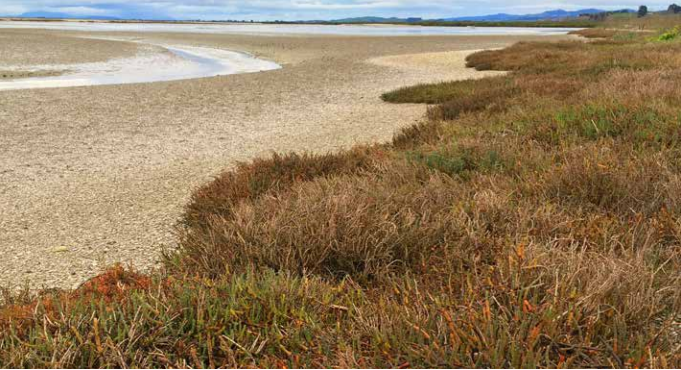
I’m sure you’ve often wondered why that rather cute, little, multi-coloured, succulent plant that decorates the edges of the Findlay Reserve was given the name ‘Glasswort’.
Well, okay, maybe you haven’t wondered that. I have to admit I’ve mostly ignored the hundreds of Glasswort plants lining the paths from the carpark as I scurried to the hides to see the waders. But now I have started thinking about the name and even finding out where it came from. So this is your chance to do the same.
Glasswort has been in my focus since June last year when I was face to face, down at eye level, with it while planting Oioi around the Stilt Ponds in the reserve. And then towards the end of the year, as I was sorting out the cannon net after not catching any Pacific Golden Plover, there was Glasswort again: strands of it in the nets!
It is a bizarre, almost upright, seaweed-looking plant, with small, segmented, short, jointed, fleshy stems, sausage-like really, in lots of colours, mostly green, reds, purples and some even sort of browns. Intriguing when you look at it closely as I was forced to do.
So thought I’d better find out more about the plant and where the ‘glass’ business came from. Dad told us as children that glass was made from sand. For years I thought he made that up as he was always playing jokes on us. And when I read that this plant received the name ‘glasswort’ as it was used in glass making, I thought ‘there’s more to glasswort than meets the eye!’
Glass has a fascinating history dating back nearly 7,000 years. But the glasswort connection seems to have arisen 1,000 years ago when European glassmakers discovered they could improve the quality of the product by adding the ashes of burned vegetation which turned out to contain potassium carbonate or potash. Then glassmakers in Venice discovered that if they used salty coastal plants, which contained sodium carbonate, they got even clearer glass.
Again, as a child, Mum had told me about Murano, an island near Venice, where the glassmakers were sent to reduce the risk of glassmaking starting huge fires and burning up the city (Murano is still famous for fancy glass today). Mum was sure they were also there so they could not easily give their glass secrets away and that sounds very logical.
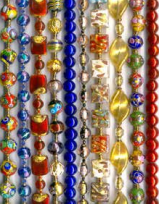
Murano Glass Beads. Image credit: Alexander-Lee 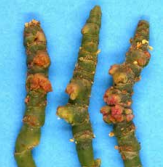
Glasswort Gall Mites and the pockets they create. Image credit: Kevin Thiele 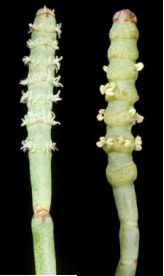
Glasswort female flowers (at left) and male flowers (at right). Image credit: Landcare Research
Anyway, it seems glassmaking pretty much disappeared from England after the Romans left until it was revived in the 16th century by the arrival of glassmakers from Europe including Murano. According to Wikipedia, ‘The Venetian glassmakers brought with them the technology of cristallo, the immaculately clear glass that used soda ash as a flux. These glassmakers would have recognized Salicornia europaea [our Glasswort’s European cousin] growing in England as a source for soda ash. Prior to their arrival, it was said that the plant “hath no name in English”.’ So they called it Glasswort.’
Over the centuries glassmaking evolved and newer and simpler ways of making glass which didn’t involve burning plants. Certainly, although Pūkorokoro had a limeworks which made lime by burning shells, there is no history of glasswort burning ash production. But by then the name had stuck.
So that’s the history, but what about the botanical side? I’m no biologist … so to the books. Glasswort belongs to the plant kingdom, family Amaranthaceae, genus Salicornia (remember the name Salicornia europaea mentioned earlier). And species? There are numerous species worldwide and New Zealand has one: Sarcocornia quinqueflora, apparently also called Beaded Glasswort, and in the olden days it was once better known as Marsh Samphire.
The sharp-eyed among you will about now be saying, ‘Aha, you said it was Salicornia and now you’re saying Sarcocornia. You’ve got it wrong!’
Well, hold on there, pedants. The Manual of the New Zealand Flora by TF Cheeseman, published in 1925, says that Salicornia is an annual or perennial herb. Cheeseman explains that our New Zealand species belongs to the subgenus Arthrocuemum moquin ‘separated from the Salicornia proper mainly by somewhat obscure embryological characters’.
If Cheeseman calls it obscure, then it must be. But the annual/perennial bit is noteworthy as it led to Glasswort having had a name change from Salicornia, as it was originally named in 1866, to Sarcocornia in 1977. And that was because it was decreed that Salicornias would henceforth be annual, whereas Sarcocornias would be perennial.
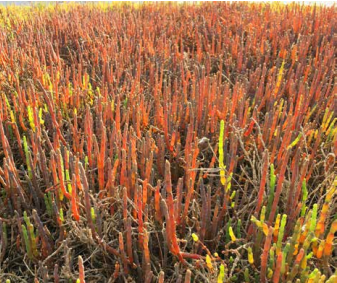
Our Glasswort – often also called Sarcocornia these days – is a flowering plant. A Guide to the New Zealand Seashore states it ‘bears small green and yellow flowers in the summer’. After learning this I looked for the flowers earlier this year, during another exercise to not capture Pacific Golden Plover, and there they were. I even managed to photograph them.
Glasswort is characterised as gynodioecious. Yes, I had to look that up, and it means they contain female and hermaphrodite plants, although it seems that in most areas Glasswort is totally hermaphrodite.
It is also a dicotyledon, meaning it has two seed leaves, and the name quinqueflora refers to the leaves having a network of veins and vascular bundles. And remember those segments? They are the leaf bases. They also help it conserve water.
In Life in the Estuary (for sale in the Centre shop) it is described as a salt tolerant coastal plant, found in intertidal areas and estuaries, sandy-muddy shores and even on rocks areas, where it can form a dense type mat.
Glasswort is a succulent, but not like the ones we have in the garden at home, as Glasswort spends half its life in a salt water environment. In other words: halophytic. What an adaptation!
It can even grow on bare mud. But because it has shallow roots, Glasswort will not grow where there are strong water currents. It is also found in inland Otago. No saltwater there, but erosion means the soils become salty if there’s no rain.
Glasswort even has its own mite: Aceria rubifaciens, the Glasswort Gall Mite, which only feeds on glasswort. My reading suggests that not much more is known about these mites but it is thought they are only found on plants in the North Island. After being down south in winter, I guess it is because they like the warmer climates, and who can blame them.
According to some books, Glasswort is also edible. Its European cousin, Salicornia europaea, is eaten cooked or raw but you have to get them before the stems become woody. Wikipedia has a recipe for a popular Turkish salad made with lemon juice, olive oil and garlic in case you’d like to try.
I am not sure if I will tuck in myself but I do now pay more attention to Glasswort. I’ve already found that in some lights, such as the setting sun down by the hides, the Glasswort stems with all their variety of colours, look like precious Murano glass beads. Stunning. Like glass it is clear (spot the pun) that Glasswort deserves a closer look.
